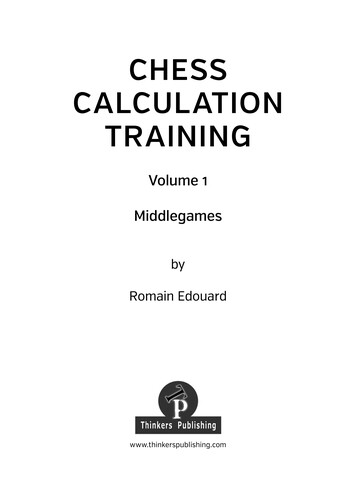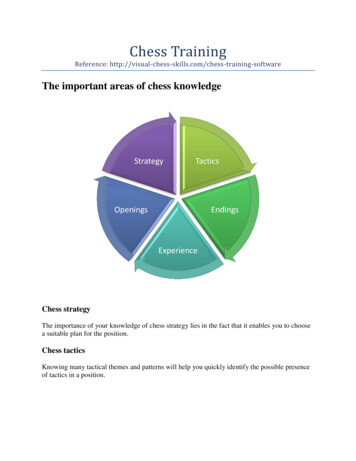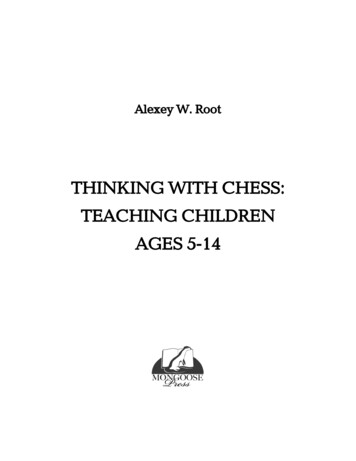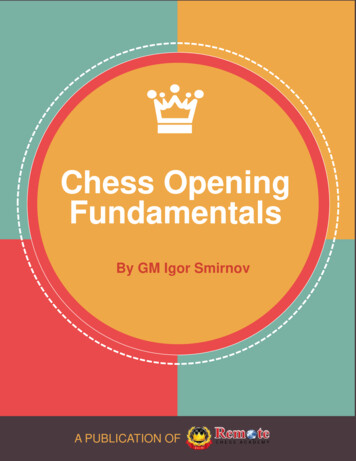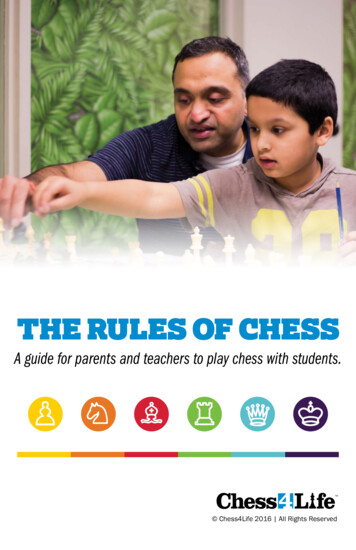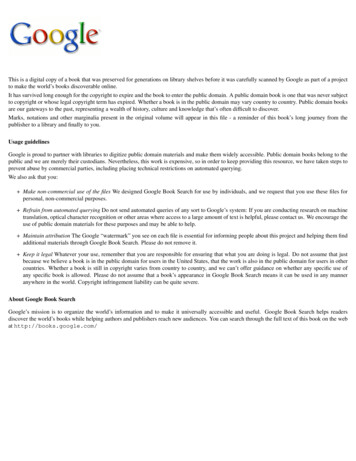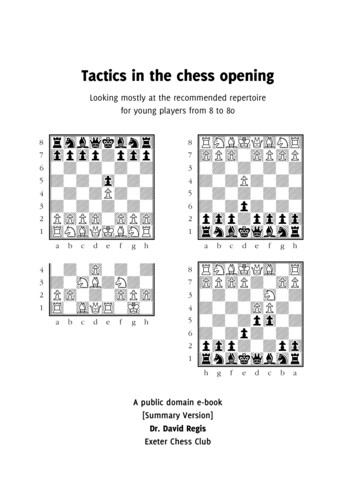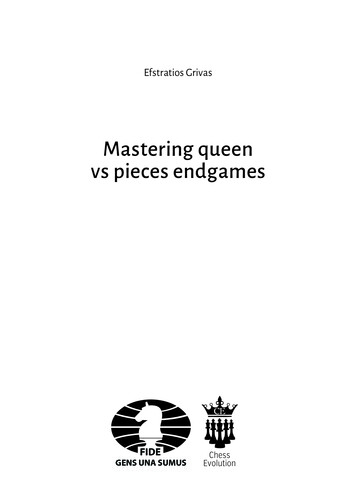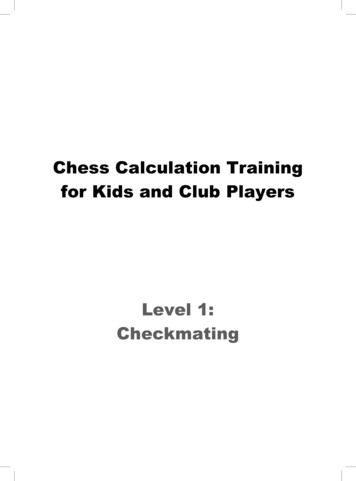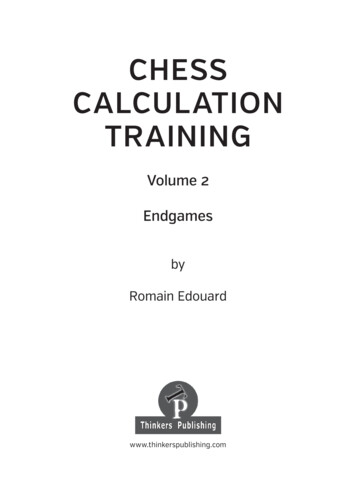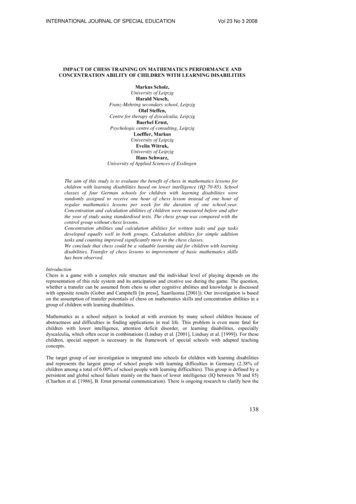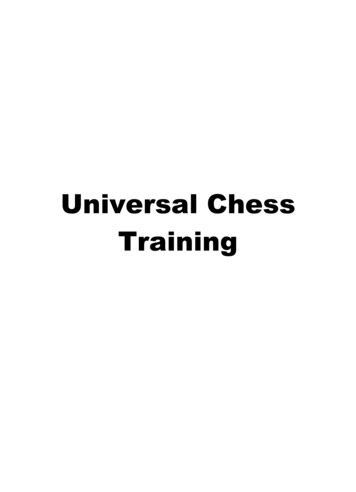
Transcription
Universal ChessTraining
First edition 2020 by Thinkers PublishingCopyright 2020 Wojciech MorandaAll rights reserved. No part of this publication may be reproduced, stored in a retrieval system or transmitted in any form or by any means, electronic, mechanical,photocopying, recording or otherwise, without the prior written permission fromthe publisher.All sales or enquiries should be directed to Thinkers Publishing, 9850 Landegem,Belgium.Email: info@thinkerspublishing.comWebsite: www.thinkerspublishing.comManaging Editor: Romain EdouardAssistant Editor: Daniël VanheirzeeleTypesetting: Mark HaastProofreading: Chris TillingSoftware: Hub van de LaarCover Design: Iwan KerkhofGraphic Artist: Philippe TonnardProduction: BESTinGraphicsISBN: 9789492510907D/2020/13730/19
Universal Chess TrainingWojciech MorandaThinkers Publishing 2020
Key to Symbols!?!!?!?! N a good movea weak movean excellent movea blunderan interesting movea dubious moveonly movenoveltylead in developmentzugzwangequalityunclear positionwith compensation for thesacrificed material - #White stands slightly betterBlack stands slightly betterWhite has a serious advantageBlack has a serious advantageWhite has a decisive advantageBlack has a decisive advantagewith an attackwith initiativewith counterplaywith the idea ofbetter isworse ischeckmate
Table of ContentsKey to Symbols .4Introduction .7Chapter 1 – What every Russian schoolboy solves.17Solutions .27Chapter 2 – Enter at your own risk: Puzzles may bite .119Solutions .129Chapter 3 – Grandmasters wept solving these .235Solutions .245
IntroductionI. What is the purpose of this book?I have always considered chess to be a difficult game to learn, especially for thoseof us who are mostly self-taught. The literally endless number of motifs, patternsor variations may seem overwhelming for many players. And then there is the needto apply this knowledge in practice. When confronted with such a vast amount ofdata, people tend very quickly to start looking for more general points of reference,or maybe even shortcuts intended to put them on the fast-track to mastery.Before reaching the GM title at the age of 21 I used to be very principled, digestingbook after book. I purchased whatever title appeared on the market – this was mymethod. With little or no access to professional coaching services, I believed thathard work (understood as memorizing idea after idea and maneuver aftermaneuver) would eventually pay off. There was little or no order within this‘learning process’, nor was there any understanding of how to apply this knowledgein a tournament game. To give you an example, I knew every single pawn-structurethat was ever discussed in textbooks, but I still felt lost like a babe in the woodswhenever my games diverged from these studied structures.Only when I started training others in my early twenties, as probably the youngestcoach in the history of the Polish National Youth Chess Academy, did I discover thatthis ‘learning process’ was not the way. I witnessed some players working as I didin the past – training extremely hard, but only seeing the fruits of their labours aftera long period of time. Indeed, so long that they were discouraged from furtherwork. This experience as a young coach taught me one very important lesson: thetraining regime of every single player needs to be not only organized aroundwhatever might be taking place on the board (plans and ideas in various stages ofthe game), but should also cover more concrete topics pertaining to thoughtprocesses and decision making.Over time, this prompted me to develop my own training system. It enabled me toguide my students on their path to chess improvement in a systematic manner.Nowadays, and as a coach at my own chess school, I prepare the curricula of mypupils in accordance with the rule of ‘three tiers’:
Exemplary training curriculumTier 1:Tier 2:Tier 3:Core TrainingPersonalized ProgramUniversal Chess TrainingBasic elements that need Targeted exercises,Thought processes andto be understood bycustomized to the needs decision making inevery single player,of the specific player and practice, whether thisirrespective of theirdesigned to eliminateinfers the application ofplaying strength andtheir particular flawsknowledge or notcurrent knowledgeCreating a distinct methodology for Tiers 1 and 2 was child’s play, but how aboutTier 3? To devise something truly instructive in this area I investigated a fewthousand games of my students. My purpose was to seek to establish what type ofmental mistakes they made most frequently. The results of my research surprisedme. I discovered that whether the given player was rated 1600 or 2500 they wereall most likely to experience difficulties when making use of the following five skills:1.2.3.4.5.Anticipation & ProphylaxisAttack & DefenseCoordinationStatics & DynamicsWeaknessStatistically speaking, the above five skills were involved in more than 80% of thestrategic problems my students were facing in their games. I quickly realized thatmastering these five skills would mean that only 20%, or every fifth problem, wouldpotentially come as a surprise to them. Taking an important exam and knowingupfront 80% of the material discussed therein sounds like quite a competitive edgeto me!As you can tell by now these skills are not something particularly concrete, butrather a general set of skills. Moreover, they are necessary if you are to learn theskill of handling your pieces properly. It will enable you to apply all the knowledgeyou have in practice. However, calling them ‘soft skills’ is not sufficient. I, therefore,prefer to speak of them as ‘Universal Chess Training’, because knowing them willmost certainly help you play a good move whether the position seems familiar ornot.And this is exactly what this book is all about. Below you will find a shortintroduction to the essentials of these five aspects. It presents basic knowledge thatwill not only enhance your results but also facilitate your ability to negotiate the
rest of this book. The information given below represents merely a quantum ofknowledge conveyed herein: every single game is meant to bring you deeper anddeeper into the discussed subject matter.II. Universal Chess Training1. Anticipation & ProphylaxisAnticipation is the ability to predict the future, to foresee the consequences ofone’s actions. Prophylaxis, on the other hand, represents the habit of constantlyasking yourself ‘What does my opponent want to do?’ and/or ‘How is the opponentgoing to respond to these intended actions of mine?’. Those are questions that may(and should!) be asked all the time and paying attention to the answers will veryrarely let you down.Those skills are so valuable because chess as such is all about being able to tell thefuture. If you can do that you are already halfway prepared for what is about tocome. In case you are wondering, the difference between anticipation andprophylaxis is as follows: prophylaxis infers the possibility of preventing theopponent’s intentions. Anticipation rather emphasizes the importance ofunderstanding the direction in which the game is going.Prophylaxis tends to have a negative psychological effect on the opponent, it is verydifficult to play if your opponent predicts your actions in advance and preventswhatever you might be up to. At the same time, we must not forget that this is nota purely defensive weapon at all. More often than not, anticipation is going toassure us that it is the right time to attack, or even compel us to do so, otherwisewe may face some hardships ourselves.2. Attack & DefenseAttacking and defending are like reflections in a mirror. The same set of rulesapplies to both situations, with the only difference being perspective. In otherwords, when attacking, we are advised to include as many pieces as we can. If weare defending, however, we are doing the exact thing albeit with a slightlyalternative goal: namely to exchange pieces to reduce the opponent’s attackingpotential.
Both approaches stem from the very same principle, known widely in chessliterature as the ‘Attack-Defense-Ratio’. In plain terms, the Attack-Defense-Ratiorepresents the difference between the number of pieces taking part in the attackand the number of pieces defending. If the difference is 2 or more the chances forsuccess are relatively high. If it is lower than 2 do not even try! The reason for thisis as follows: whenever you start an attack you need to take into consideration thatthe number of your pieces present on the board might decrease at quite a rapidpace, whether through possible exchanges or sacrifices. The surplus of 2 or morepieces means that, at the end of the day when the opponent’s king is left alone anddefenseless, you will still have enough forces at your disposal to mate him.Obviously, this is a very crude rule and a multitude of reservations need to bementioned. First, the issue is not solely about the quantity of the pieces taking partin the attack, but also about their quality. For example, you usually would not wantto start an onslaught against a black king castled kingside without a knight driftingsomewhere around the f5-square. Also, the coordination of your forces cannot beunderestimated either. The last thing you want to see is a large number of yourpieces failing to storm the barricades of the opponent’s inferior position simplybecause his defensive arrangement happens to be better organized.3. CoordinationCoordination means the number of possibilities your pieces happen to enjoy in agiven position. This can pertain to a single piece or many pieces altogether. Themost famous derivative of this rule is the principle of the weakest piece. Accordingto this principal it takes only one piece of yours to be ‘bad’ to spoil your entireposition. For this reason, the principle of the weakest piece should be consideredas a practical guideline. Whenever you have time during a game, you may want toconsider how to improve your weakest piece. Examples of ‘bad’ pieces include thelight-squared bishop in the French Defense and knights on the edge of the board.But make sure that you do not follow this rule blindly. After all, some hypermodernopenings like the King’s Indian Defense may surprise you in this respect more thanonce.In this book we divide the means required to improve the coordination of piecesinto two groups: static and dynamic. Static means bringing one of your pieces togreener pastures. For example, re-routing White’s dark-squared bishop in theWinawer to the splendid a3-square. Such endeavors clearly improve the situationon the board, but usually affect only the coordination of the piece involved.
Dynamic means, on the other hand, imply a drastic change to the character of theposition, leading to a global modification of the capabilities of all of your pieces.This can happen in the form of a pawn-lever (e.g. the .e6-e5 push in the FrenchDefense), or after the material balance becomes disturbed (e.g. after a positionalexchange-sacrifice on c3 in the Sicilian Defense).Because chess involves two players, it is not only the coordination of your ownpieces that need to be taken care of. You may also need to dedicate some time tospoiling the efforts of your opponent. If you can kill two birds with one stone, thatwould be even better!4. Statics & DynamicsTo speak of things ‘static’ in chess means everything that is stable and subject tochanges only under a considerable amount of force, e.g. the pawn-structure or thematerial balance in an otherwise calm position. Enjoying a static edge usuallyimplies that if nothing changes this type of advantage is going to allow us to bringthe full point home without any undue adventures. By comparison ‘dynamics’ takeplace in a game of chess when the balance is disturbed, e.g. when one of the playerssacrifices material for something intangible be it an attack or initiative. The natureof a dynamic edge tends to be ephemeral – it can be raging at a given moment onlyto disappear completely two moves later if mishandled.The above distinction is not only of theoretical importance as we must be able tograsp what kind of position we have in front of us. It means that we will know whenwe need to change the nature of the position. Suppose we are being dominated byour opponent and we need to break his progress. When doing so, however, thereare two guidelines that need to be followed:a. If our opponent has a strategically superior position (e.g. due to a smalleramount of pawn-weaknesses in his camp), you would usually be advised to‘wiggle’, that is to destabilize the position by seeking tactical/dynamicopportunities.b. However, when finding yourself under dynamic pressure (e.g. when underattack or when the opponent has the initiative), the best way of counteringthis will be to drain the activity out of the opponent’s position. If successful,whatever remains of the position afterwards should favor us, especially ifit was positionally advantageous for us from the start.
5. WeaknessIn general, a ‘weakness’ represents an element of the position which is notdefended well enough. Moreover, this weakness should be defended due to itsimportance for the assessment of the position as a whole. There can be as man
What is the purpose of this book? I have always considered chess to be a difficult game to learn, especially for those of us who are mostly self-taught. The literally endless number of motifs, patterns or variations may seem overwhelming for many players. And then there is the need to apply this knowledge in practice. When confronted with such a vast amount of data, people tend very quickly to .
